MRRL Hall of Fame
SRC (Scot Richard Case)
- Details
- Category: Inductees
- Created: Tuesday, 04 October 2011 10:33
- Written by Gary Johnson
The teenage band scene in the 1960s in Southeast Michigan was the product of Motown and the soul music blasting out of Detroit, and the British Invasion bands led by the Beatles. Billy Lee and the Rivieras (soon to be renamed Mitch Ryder and the Detroit Wheels) were one of the first teen bands in the Motor City to feature a lead singer. They initially gained a name for themselves at The Village, one of Detroit’s early music clubs located on Woodward Avenue.
Most young bands in the Detroit area in the early 60s played instrumentals in the style of Johnny and the Hurricanes or the Ventures. The Royaltones, from Dearborn, Michigan, were the leading local instrumental group. They charted two hits ("Poor Boy" and "Flamingo Express") on the Billboard Hot 100, and backed Del Shannon on several of his recordings. 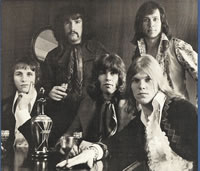 SRC: (L to R) Al Wilmot, Gary Quackenbush, Glenn Quackenbush, Scott Richardson, E. G. Clawson
SRC: (L to R) Al Wilmot, Gary Quackenbush, Glenn Quackenbush, Scott Richardson, E. G. Clawson
One of the teen bands on the scene in 1963 that highlighted a lead singer was the Tremolos out of Birmingham, Michigan. With John Boyles on vocals and bass, Rett Nichols on lead guitar, E. G. Clawson on drums, Gary Quackenbush on rhythm guitar, and his brother Glenn on electric piano, the Tremolos were doing very well playing mostly instrumentals at high school dances, weddings, and University of Michigan fraternity parties.
It was at a U of M party that they met a student named Ed “Punch” Andrews. Andrews was impressed with the Tremolos, and he hired them to play at a New Year’s Eve party in Grosse Pointe where he introduced them to Dave Leone. Andrews and Leone were long-time friends who shared a dream of becoming record executives.
Leone and Andrews approached the band about making a recording of a Dave Leone original called “A Fugitive”, inspired by the popular television series. They convinced the Tremolos to change their name to 'The Fugitives' as part of the deal. After Andrews returned to classes at U of M, Leone brought the band to United Sound studio in Detroit and recorded a single with “A Fugitive” on one side with vocals, and “A Fugitive” as an instrumental on the flip.
Released on D-Town, a small Detroit R&B label, the record was played on WXYZ. It was not even a local hit, but the single did provide the Fugitives with both publicity and prestige. When Leone and Andrews opened a new teen club in a VFW hall in Harper Woods called the Hideout, in May of 1964, the Fugitives were hired as the venue’s house band.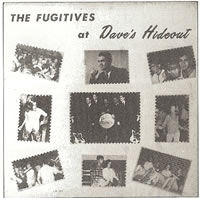 Hideout Records LP
Hideout Records LP
Following a second single by the band on D-Town, “On Trial" b/w "Let’s Get On With It”, Leone decided to release an album on his own label in order to promote both the Fugitives and his new club. Leone’s Hideout Records thus became the first local record label to emerge from the new garage band scene. Recorded in the den of the Quackenbush home, Leone cleverly made it sound like a live album by recording the crowd noises of the kids at the Hideout and combining them with the music to produce “The Fugitives Live at Dave’s Hideout”. Three hundred copies of the album were pressed and sold at the club for $3 each.
Hideout Records would go on to release a batch of classic 1960’s singles from a host of other Detroit-area teen bands including Bob Seger & The Last Heard, Doug Brown and the Omens, the Underdogs, the Pleasure Seekers (featuring Suzi Quatro), the Four Of Us, T.R. and the Yardsmen, the Torquays, and the Mushrooms (featuring Glenn Frey).
Following another single, “You Can’t Make Me Lonely”, on Westchester Records, the older members of the Fugitives (Glenn Quackenbush and Rett Nichols) quit the band to attend college. They were replaced by Butch Hamilton on piano and Paul Kelcourse on lead guitar. Gary Quackenbush, who was still in high school, joined a rival Birmingham band called the Yorkshires in the summer of 1965.
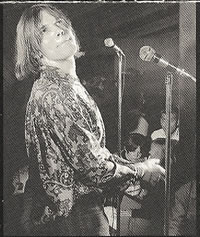 Scot Richardson
Scot Richardson
Looking to take another step forward in establishing a career in music, the Fugitives hooked up with rock and roll visionary, Hugh “Jeep” Holland in Ann Arbor, Michigan. Holland had come to Ann Arbor to attend the U of M, but found his true calling when he started running the campus branch of Discount Records, got into local band management, and then started recording them on his newly formed A-Square label.
It was Holland’s idea to have Scott Richardson, the dynamic lead singer of the Chosen Few, join the band in late 1966 after John Boyles decided to call it quits. The Chosen Few had recently played at the Grande Ballroom but the band, which also included future Stooges Ron Asheton and James Williamson, was on the verge of breaking up.
Richardson was a good fit since both the Fugitives and the Chosen Few loved the British groups of the day and played covers of songs by the Stones, Yardbirds and The Who. The new combination, which now included Robin Dale on bass, Glenn Quackenbush on keyboards, Steve Lyman on guitar and backing vocals, E.G. Clawson on drums, and Gary Quackenbush, who had left the Yorkshires, on lead guitar for the first time. According to Steve Lyman, this new lineup was without a name until the middle of January in 1967 when they decided on calling themselves the Scot Richard Case, with Scott Richardson shortening his stage name and Case taken from Steve Lymon's middle name.
Around the time the new lineup started practicing, Holland got an import copy of Cream’s first album "Fresh Cream". The band fell in love with Cream’s cover of the Skip James' song “I’m So Glad”, and they quickly worked it into their repertoire. For the band's first single of A-Square, however, Holland suggested a cover of a Pretty Things' album cut called "Get The Picture". It was backed by an original song written by Richardson and Lyman called "Who Is That Girl?" Both songs were recorded at United Sound in Detroit. 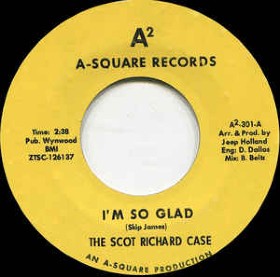 "I'm So Glad" 45
"I'm So Glad" 45
Before the single was released, the Scot Richard Case made its first public appearance in Fenton, Michigan. The crowd response to their version of "I'm So Glad" was so great that Holland insisted that they return to the studio to record it. The song was put out as the A-side of the first Scot Richard Case single, with “Who Is That Girl?” as the B-side. Their classic recording of “I’m So Glad” became a # 1 hit in 1967 on WTAC in Flint and a Top Ten hit in Detroit, making the Scot Richard Case one of the hottest groups in Southeast Michigan. They were the most classically 'mod' of all the Michigan bands, but Holland was unable to break the record outside of the state.
The Scot Richard Case was formed with the understanding that the band would be full-time work. That being the case, the band traveled around Michigan visiting radio stations and spent a lot of time developing a stage presentation that combined stellar musicianship with plenty of showmanship and flash. In their early days the band played all over the state at venues that included the Hideout clubs, the Grande Ballroom in Detroit, fraternity parties at a variety of Michigan colleges, the Fifth Dimension in Ann Arbor, The Palace in Grand Rapids, Mt. Holly in Flint, and the Tanz Haus near Traverse City.
Although the band was writing and performing some original material, Nothing other than "Who Is That Girl?" was recorded. Their repertoire during shows was primarily covers of what they considered to be the best rock and roll songs. The Scot Richard Case also became known for the British-inspired Carnaby Street outfits that they wore on stage, and they even drove to New York on one occasion just to buy clothes. Scott Richardson had a suit that he wore on stage that was covered with hundreds of tiny light bulbs that flashed to the beat of the music.
According to Richardson, the band was interested in reinventing its musical influences into something entirely new and different, and that their philosophy was as important as their ability to perform. The Scot Richard Case saw its original music as having a definite message and they were willing to risk everything in order to communicate it on their terms alone. This philosophy put them in almost constant conflict with Jeep Holland who was trying to exert artistic control of the band at the same time that they wanted, in Richardson’s words, “To present something that no one had ever heard before, anywhere, except in the deepest part of their mind and spirit.”
Near the fall of 1967, the Scot Richard Case split with Jeep Holland and selected Pete Andrews to be the band’s new manager. Andrews was the polar opposite of Holland in that he basically left the music to the band and concentrated on booking shows.
No longer wishing to focus on any individual in the band, the Scot Richard Case changed their name to simply SRC. Producer John Rhys introduced the band to Capitol Records, and SRC signed with the label in 1968. In November, Al Wilmot replaced Robin Dale on bass and backing vocals after SRC completed their first out-of-state tour in the northeastern part of the U.S.
Jeep Holland was hurt by the departure of the Scot Richard Case. As with the other bands on his A-Square roster, he had helped them with their stage moves and taught them other little tricks like talking to their audience after a gig and signing autographs to build fan loyalty. After they had changed their name to SRC and signed with Capitol, Holland issued an unusual single on A-Square with “I Need You” by the Rationals on one side, and “Get The Picture” on the other, with the group billed somewhat bitterly as “The Old Exciting Scot Richard Case”.
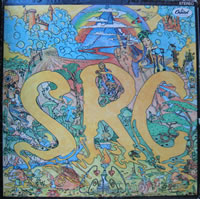 Debut album on Capitol
Debut album on Capitol
The band’s debut album, the eponymously titled “SRC”, was produced by John Rhys and recorded at the Tera Shirma studios in Detroit. Released in the fall of 1968, the album’s eight songs were all credited to SRC. The collection remains the band’s most cohesive musical presentation as far as incorporating their influences of poetry, Eastern philosophy, psychedelics, and deep spiritual questing all wrapped in heavy, Motor City-styled rock. The highlights included the lead track “Black Sheep”, the ominous “Onesimpletask”, “Refugeve”, and the guitar-drenched album closer, “Interval”. The LP was a big hit in Michigan, but reached only # 147 after four weeks on Billboard’s album chart.
Capitol released a shortened version of “Black Sheep” as the band’s first single, backed by the instrumental “Morning Mood”. “Black Sheep” featuring Glenn Quackenbush’s doomy organ passages, brother Gary’s sustained guitar notes, E.G. Clawson’s pounding drumbeats, and Richardson’s yearning vocal, is in many ways the ultimate SRC song. As with so many of the state’s great 60’s bands, however, the single got substantial airplay on important Michigan AM stations but failed to chart nationally.
In support of their debut album, SRC played the Oakland Pop Festival in Rochester, Michigan, on Labor Day weekend along with headliner Procol Harum (one of their British influences). SRC also played the Boston Tea Party with the James Cotton Band, Olympia Stadium with The Crazy World of Arthur Brown and the MC5. The band also performed at the Grande Ballroom, Club Limberlost in Leonard, Michigan, and several of the Hideout clubs as 1968 drew to a close. 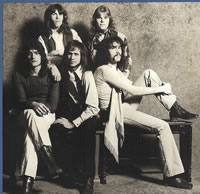 SRC
SRC
SRC had a big fan in Great Britain in the person of influential radio deejay John Peel. Although “SRC” was only available as an import until 1969, Peel played several tracks from the album on his program and helped establish a British fan base for the band, including Peter Gabriel who had just founded his first band, Genesis.
SRC began work on their second album in November of 1968.“Milestones”, was produced by John (Rhys) Eddins and SRC and released in the spring of 1969. It shows a band at the very top of its game with nine of the album’s ten varied songs credited to SRC. The only cover was an instrumental that was a crowd favorite at SRC’s live shows, a medley of “In The Hall Of The Mountain King” and “Beck’s Bolero”. The band had been using it as a set-closer as far back as the summer of 1968.
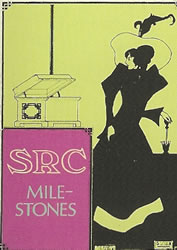
The rest of “Milestones” was made up of original material that ranged from pop (“Show Me” and “Our Little Secret”) to R&B ("Turn Into Love”), to psychedelic rock (“No Secret Destination” and “Eye Of The Storm”), and Detroit-styled hard rock (“Checkmate” and "Up All Night”). The album closer was the mystical “Angel Song” an eight-minute opus featuring Scott Richarson’s spoken vocal, Steve Lyman's lead guitar on the first part and Gary Quackenbush’s 'crying' guitar on the second half. Although credited on the album, guitarist Steve Lyman and SRC had parted ways near the end of the recording, and the band was now a five-piece.
“Milestones” did better sales-wise than “SRC”, spending 9 weeks on Billboard’s album chart and peaking at # 134. The album even got a substantial airplay in Europe, especially London and Amsterdam. The response was great enough for EMI (the giant British corporation that owns Capitol Records) to pick up “Milestones” for release over there. Despite their popularity abroad, however, SRC was never able to tour outside of the U.S.A. except for Canada.
“Up All Night” was chosen as the A-side for SRC’s next single with “Turn Into Love” as the B-side. Unfortunately soon-to-be-disgraced Republican Vice President Spiro T. Agnew had recently lashed out against the recording industry for promoting the “drug culture”. The FCC followed Agnew’s speech with a memo to radio stations cautioning them that their licenses could be endangered if they played songs glorifying drug use. Although “Up All Night” contains no direct references to drugs, the word “Up” seemed questionable enough to remove the song from some radio playlists, even in Michigan.
The band used advance money from Capitol to build their own studio, called the Morgan Sound Theatre, at the band house located near the intersection of Plymouth and Broadway in Ann Arbor. They purchased a Skully half-inch, four-track tape machine from United Sound in Detroit, and they were able to work on their songs much more freely than would have been possible in any other studio.
SRC played relentlessly in support of “Milestones”, including a four-night gig at the Boston Tea Party with Julie Driscoll, Brian Auger & Trinity, the Detroit Pop Festival at Olympia, the Grand Rapids Pop Festival, the Saginaw Pop Festival at the Saginaw Auditorium, the grand opening of the Eastown Theatre in Detroit, Daniel’s Den in Saginaw, and the First Annual Rock & Roll Revival at the Michigan State Fair that also featured the Michigan debut of Grand Funk Railroad.
The band also had a very importance appearance at the Toronto Pop Festival on June 21, 1969. According to Creem magazine; “They received standing ovations both days, but more significant was their attitude the entire weekend. They voluntarily played a spur-of-the-moment street dance the night before the festival. In addition, they played a 3:00 a.m. set at the Rock Pile club after spending the entire day at the festival grounds, sticking around to watch the other groups, and just generally having a good time, instead of disappearing the moment their set was finished like most groups did”. 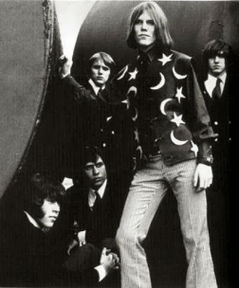 (lower left to right) Glenn Quackenbush, E. G. Clawson, Steve Lyman, Scott Richardson, and Robin Dale
(lower left to right) Glenn Quackenbush, E. G. Clawson, Steve Lyman, Scott Richardson, and Robin Dale
Returning to the States, SRC performed before 20,000 people on the 4th of July at the Saugatuck Pop Festival along with Muddy Waters, John Lee Hooker, Procol Harum, the Amboy Dukes, and the MC5. SRC also appeared at the Midwest Rock Festival in Wisconsin with Blind Faith and Delaney and Bonnie, and the Rock Concert and Jazz Festival in Petoskey, Michigan, with the Frost and John Mayall.
After the Petoskey show, SRC began a short but disappointing tour of the West Coast playing three nights at the famous Fillmore West and also at the Avalon Ballroom. The laid-back audiences in San Francisco had little or no appreciation of Detroit rock and roll bands, and SRC’s reception at the shows was tepid at best. In addition, Gary Quackenbush and the rest of the band were fighting, and the poorly received shows in California seem to bring things to a head.
Upon returning to Michigan, SRC decided to move in a slightly different direction, and they made a crucial decision by replacing guitarist Gary Quackenbush with Ray Goodman. Quackenbush’s guitar had been one of the cornerstones of SRC’s sound, and in his absence rumors began to fly that he had been seriously injured in a motorcycle accident or that he had completely freaked out after a bad L.S.D. trip. In the Creem interview, however, Scott Richardson denied the rumors by explaining, “We’d been to San Francisco, and we’d learned some things and had gotten it into our heads what our next level of working would be. We just had to make another step and he couldn’t make it with us. But it wasn’t from a flip out from a motorcycle accident, like many thought”. 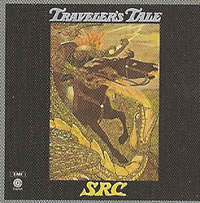 Third Capitol LP
Third Capitol LP
With Ray Goodman on guitar, SRC bought an eight-track recorder for their studio and began work on their third album in the fall of 1969. “Traveler’s Tale” was completed in December and released in early 1970. Goodman was a very good guitarist but, without Quackenbush, SRC had lost a very big part of their distinctive sound, and the album sold poorly despite containing some stellar tracks.
“Street Without A Name”, “Midnight Fever”, and “By Way Of You” were all strong cuts but SRC now sounded like a different band. A good example was “The Offering”, which utilized thirty strings and five French horns and was arranged by classical musician Bob Boury. The overproduced song didn’t really add to the album’s appeal, nor did it sound like anything that remotely resembled “Black Sheep." Capitol released “Never Before Now” along with the non-album cut “My Fortune’s Coming True” as a single, but it suffered the same fate as the album.
After the failure of “Traveler’s Tale”, Goodman left and Gary Quackenbush rejoined the band. Quackenbush returned just in time to play the Goose Lake International Music Festival just outside of Jackson, Michigan. Promoted as Michigan’s rock and roll mega-event of 1970, it attracted an estimated crowd of 200,000 rock music fans. Despite its impressive line-up of both national and local talent, Goose Lake was portrayed in the media as an overcrowded example of how much hard drugs like heroin and crystal meth had invaded the Michigan rock and roll scene. Although the vast majority of the festival attendees had a great time, the resulting avalanche of negative publicity from the event effectively killed off the whole pop festival movement in the state. 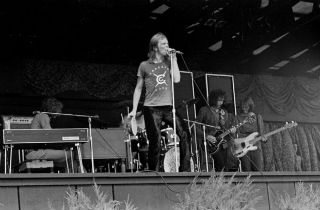 SRC at Goose Lake
SRC at Goose Lake
Hard drugs had definitely taken a toll on the once vibrant Detroit music scene. According to the Stooges’ Ron Asheton, “Once heroin was introduced into the picture, it was the beginning of the end. It had changed from smoking pot to smoking angel dust. It was like an epidemic. Instead of doing things for stimulus, the stimulants became crystal meth. To get laid back, instead of smoking weed, people were doing heroin."
By the start of the new decade, the teen clubs that had flourished around the state in the 1960s were going out of business because of the competition from the big rock concerts, and even the Grande Ballroom was on its last legs. This began to limit the venues for a band like SRC, who had just had their option dropped by Capitol after three quality releases because they had failed to make a significant sales breakthrough.
SRC played as often as they could during the rest of 1970 and all of 1971 while they tried to get another record deal. Included were headlining shows at Sherwood Forest in Davison, Michigan, and opening for two shows with the Ike & Tina Turner Review in Ann Arbor and Detroit. In July of 1971, SRC also played two shows billed as the Blue Scepter at the Eastown Theatre in Detroit on a bill with Ted Nugent and The Amboy Dukes. By this time, Al Wilmot had left the band and had been replaced by Richard “Shemp” Haddad on bass.
The band released “Born to Love" b/w "Badaz Shuffle” as a one-shot single on their own Big Casino label in early 1971, but it did nothing on the charts. By the end of 1971, SRC had signed with Rare Earth Records, a rock and roll subsidiary of Motown that had been having a great deal of success with the Detroit rock band called Rare Earth. The label had also signed the Pretty Things, a major influence of SRC, and released two critically acclaimed albums on the British band. 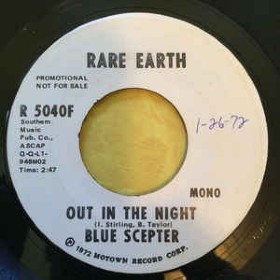 SRC as Blue Scepter
SRC as Blue Scepter
Thinking that a name change might help their career, SRC recorded a single on the Rare Earth label as Blue Scepter. Both sides of the record, “Out In The Night” and “Gypsy Eyes” were from a batch of new songs that had been written and recorded by the band at their studio in Ann Arbor for a planned fourth album. When the single, released in early 1972, failed to click, Rare Earth passed on releasing the album. By June of 1972, the band had dropped the name Blue Scepter and performed as SRC for the remainder of the year.
According to Gary Quackenbush, “SRC was about as far from a bar band as you could ever imagine, but we found ourselves playing in them, so we knew it was sliding at that point. The band was also suffering from poor management. The whole last year, we were without a manager. We did it all ourselves, and we were deep in debt”. Discouraged and out of funds, SRC played its last gig in January of 1973.
SRC’s records had been out of print for years until One Way Records began reissuing their original albums (some with bonus cuts) in the 1990s. In 1993, One Way released “Lost Masters”, a 20-song set that collected all the recordings that SRC made as Blue Scepter, as well as a group of outtakes recorded during the band’s final days at Capitol.
In the years after the break up of SRC, Scott Richardson relocated to Los Angeles and got involved in the film business. Richardson served as a writer for Hearts Of Fire which featured Bob Dylan and also worked on the sets of two of the Lord Of The Rings films. Gary Quackenbush played in the Sunday Funnies in 1973 and 1974, did session work, taught guitar and multi-track recording, and established SRC Records before he passed away in 2015. Richard Haddad died in a car accident in 1977, E.G. Clawson died of cancer in 2003, and Al Wilmot passed away in 2005. 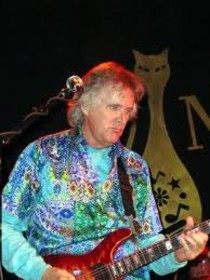 Steve Lyman at SRC reunion
Steve Lyman at SRC reunion
SRC was voted into Michigan Rock and Roll Legends Internet Hall of Fame in 2010. In addition, the band's recordings of "Black Sheep" (2016) and "In The Hall Of The Mountain King/Bolero" (2019) have been voted Legendary Michigan Songs.
After leaving SRC in 1969, Steve Lyman had little contact with his former bandmates until the partial SRC reunion gigs in 2003, 2004, 2011, and 2012, plus the Detroit Music Awards in 2017. In a recent email he stated: "I was somewhat reluctant to do those gigs, knowing that in no way were we going to be able to duplicate what we had been in the late 1960s".
MRRL Hall of Fame: https://www.michiganrockandrolllegends.com/mrrl-hall-of-fame
Video: Watch a video from the SRC reunion show at White's Bar in Saginaw from 2011. The performance is of their great instrumental "In The Hall Of the Mountain King/Bolero". Behind the stage is the parking lot where Daniel's Den once stood https://www.youtube.com/watch?v=E30u0OIACpc
Dr. J. Recommends:
“SRC” (Bonus Tracks)” CD One Way Records. SRC’s classic first album includes the first Capitol single; a different version of “Black Sheep” along with its B-side, “Morning Mood”.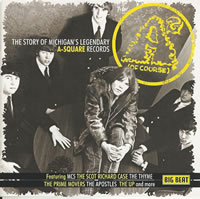 "A-Square (Of Course)" CD
"A-Square (Of Course)" CD
“Milestones” CD One Way Records. My favorite SRC album. This, along with the first LP, is a must-have for any serious fan of Michigan rock and roll.
“A-Square (Of Course)” CD Big Beat Records. This is an excellent compilation of bands who recorded for Jeep Holland’s label. The CD has five cuts by the Scot Richard Case - the three songs released as singles and two unreleased recordings. This is essential for SRC fans; plus you also get an outstanding booklet along with some other great Michigan tunes by the Thyme, the Bossmen, the MC5, and Dick Wagner & the Frost.
